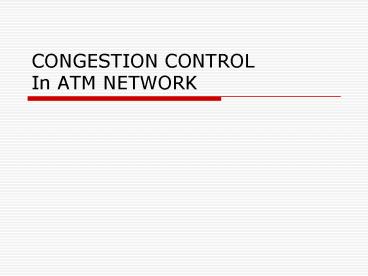CONGESTION CONTROL In ATM NETWORK - PowerPoint PPT Presentation
1 / 33
Title:
CONGESTION CONTROL In ATM NETWORK
Description:
ATM architecture was designed with a view to transmitting voice, video and data ... ATM architecture is based on packet switching principle and is connection oriented. ... – PowerPoint PPT presentation
Number of Views:386
Avg rating:5.0/5.0
Title: CONGESTION CONTROL In ATM NETWORK
1
CONGESTION CONTROL In ATM NETWORK
2
OVERVIEW ATM NETWORK
3
INTRODUCTION
- ATM architecture was designed with a view to
transmitting voice, video and data on the sme
network. - ATM architecture is based on packet switching
principle and is connection oriented.
4
- These different types of traffic have different
tolerance levels for packet loss and end to end
delay.
5
ATM CELL
- ATM packet is known as cell, and it has a fixed
size of 53 bytes. - It consist of a payload of 48 bytes and a header
of 5 bytes.
6
ATM PROTOCOL STACK
- Consists of physical layer, ATM layer, ATM
adaptation layer and aplication. - ATM layer and ATM adaptation layer do not
correspond to any specific layers of the OSI
reference model.
7
(No Transcript)
8
ATM SWITCH ARCHITECTURE
- Main function to transfer cells from its
incoming links to its outgoing links. - A generic model of an ATM switch consisting of N
input port and N output port.
9
- Each input port, output port and fabric have a
finite capacity buffer.
10
- Cell lost might occur at the input port, within
the switch fabric, or at the output port.
11
TRAFFIC CHARACTERIZATION
12
TRAFFIC PARAMETERS
- Peak Cell Rate (PCR)
- the maximum amount of traffic that can be
submited by a source to an ATM network, and is
expressed as ATM cells per second. - Sustained Cell Rate (SCR)
- An upper bound of the average cell rate.
- SCR of a source can not be largerthen the
sources PCR and nor can it be less than the
sources average cell rate.
13
- Maximum Burst Size (MBS)
- maximum number of cells that can be submitted by
a source back to back at peak cell rate. - Burstiness
- a source is bursty if it transmits for a time
and then become idle for a time.
14
EMPIRICAL MODELS
- To predict the amount of traffic generated by a
variable bit rate MPEG video-coding algorithm. - These empirical models are statistical models and
are based on regression techniques.
15
- The number of bits produced by each frameis such
a sequence is correlated and it can be predicted
using an autoregressive integrated moving average
(ARIMA) model.
16
PROBABILISTIC MODELS
- It capture some of the traffic parameters, and in
view of this, they are extremely useful in
performance evaluation studies. - ATM sources are classified into constant bit rate
(CBR) and variable bit rate (VBR)
17
CBR sources
- Ex E1, unencoded voice, unencoded video.
- Arrival process is easily to characterize, since
the generated traffic stream is constant. - CBR source can be completely characterized by its
PCR.
18
VBR source
- A commonly used traffic model for data transfer
is the on/off process.
19
- On periode a source is assumed to transmit
- Off periode source does not transmit
- A cell might be transmitted with every slot or
every fixed number of slots, depending upon the
sources PCR and the link speed.
20
CONGESTION CONTROL
- Categories in congestion control
- Preventive Congestion Control
- Call admission control
- Bandwidth enforcement
- Reactive Congestion Control
21
Call Admission Control
- Clases of CAC Algorithms
- Nonstatistical ? CBR
- Statistical ? for bursty source
- ?sum of the peak bit rates of all of the
connection can exceed the link capacity
22
Call Admission Control
- In PVC ? queueing problem
- Based on cell lost rate
- Based on cell transfer delay
23
Call Admission Control (cont)
- Equivalent Bandwidth
- Ksize of queue
- Rpeak bit rate
- rfraction of time the source is active
- bmean duration of the on period
24
Call Admission Control (cont)
- Equivalent Bandwidth
- Equivalent bandwidth of N source
Average bit rate of all source
Equivalent bandwidth of ith source
Sum of standart deviation of the bit rate of all
of the source
25
Call Admission Control (cont)
26
Call Admission Control (cont)
- ATM Block Transfer Scheme
- Fast bandwidth allocation scheme
- For VBR source whose peak bit rate lt 2 links
capacity
27
Call Admission Control (cont)
- Virtual Path Connection
28
The Leaky Bucket
BANDWIDTH ENFORCEMENT
29
Arrival Time at the UNI
T 1/PRC
BANDWIDTH ENFORCEMENT
30
The Virtual Scheduling algorithm
- KEADAAN AWAL TAT ts
- Contoh
- 5 sel yg datang? 0,12,18,20,25
- T 10, ? 15
- 1.Untuk ts 0
- TAT0?TAT0?TAT 01010
- 2.Untuk ts 12
- TAT1012?TAT12? TAT121022
- 3.Untuk ts 18
- TAT22gt18?TATlt1815 (22lt33)?TAT221032
- 4.Untuk ts 20
- TAT32gt20?TATlt2015 (32lt35)?TAT321042
- 5.Untuk ts 25
- TAT42gt20?TATgt2515 (42gt30)?TAT42(tdk brubah)
TAT Theoritical Arrival Time
BANDWIDTH ENFORCEMENT
31
Continous State Leaky Bucket Algorithm
- Keadaan awal X 0 LCT ts
- Contoh
- 5 sel yang datang ? 0,12,18,20,25
- T 10 ? 15
- 1.Untuk ts 0
- X0-(0-0)0?X0?X01010
- LCT 0
- 2.Untuk ts 12
- X10-(12-0)-2?X0?X01010
- LCT 12
- 3.Untuk ts 18
- X10-(18-12)4?Xlt?(4lt15)?
- X41014LCT 18
- 4.Untuk ts 20
- X14-(20-18)12?X ?(12lt15)?
- X121022LCT 20
- 3.Untuk ts 25
- X22-(25-20)17?Xgt ?(17gt15)?
- X14 dan LCT 20(tdk berubah)
X value of leaky bucket counter X auxilary
variable
BANDWIDTH ENFORCEMENT
32
Reactive Congestion Control
- Available Bit Rate (ABR) Service
- At connection setup time, end device request MCR,
also specifies its PCR - Not intended to support real-time application
- Control mechanism using resource management (RM)
cells
33
- terimakasih































